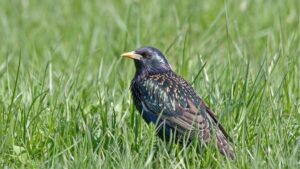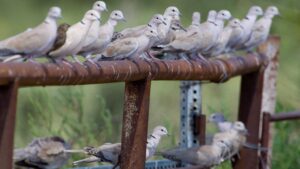Birds
Our Feathery Foes
Birds make for a unique pest; unlike other pests, birds are extremely smart. Numerous studies have proven that they can adapt to environments by learning new skills, utilize tools, recognize patterns, and even recognize specific human faces.

Bird pest management is delineated into two groups: native or invasive birds. Native bird species are protected under the Migratory Bird Treaty Act of 1918. A native bird is one who is indigenous to the surrounding area or occur occasionally through seasonal migratory patterns.
Most bird pest issues are caused by invasive bird species. An invasive bird is an alien, non-native species that have been intentionally introduced to the area. They are generally non-migratory and can often push out native species in the competition for resources such as food, shelter, and water. These birds are not protected under the Migratory Bird Treaty Act of 1918.
What is the Migratory Bird Treaty Act of 1918 (MBTA)?
In 1918, the U.S. Fish and Wildlife passed, along with Mexico, Canada, Japan, and Russia, the Migratory Bird Act which is intended to ensure the sustainability of populations of all protected migratory bird species. The MBTA prohibits the take (including killing, capture, selling, trading and transport) of protected migratory bird species without prior authorization by the Department of Interior U.S. Fish and Wildlife Service. Failure to comply with the MBTA can result in heavy fines.
Key Risks
Disease transfer between birds and humans.
Birds can cause extreme damage to a building.
Millions of dollars in crop loss and damage are attributed to birds.
Birds strikes on airplanes
There are 4 main types of Invasive Birds:
- Feral Rock Dove (Pigeon): The feral rock dove is what is commonly known as
 a pigeon. They are 12 – 15 long and can weigh up to a 1lb. They are found in all 50 states and are concentrated in urban area. They primarily feed on seeds, grains, food scraps, and leavings. They have 3-4 broods a year, with two eggs but up to 4 is possible. Eggs hatch within 18 days and their young leave the nest after a month.
a pigeon. They are 12 – 15 long and can weigh up to a 1lb. They are found in all 50 states and are concentrated in urban area. They primarily feed on seeds, grains, food scraps, and leavings. They have 3-4 broods a year, with two eggs but up to 4 is possible. Eggs hatch within 18 days and their young leave the nest after a month. - Starling: The starling is 7.5 – 8.5 inches in length and weigh 2 – 3oz. In the wild,
 they are known to live over 5 years. They are also found in all 50 states and concentrate in urban areas. They feed on insects, fruits, seeds, and grains. They have 2 broods a year, with up to 4 or 5 eggs per clutch. Eggs have a 12-day incubation period, and the young will leave the nest after 3 weeks.
they are known to live over 5 years. They are also found in all 50 states and concentrate in urban areas. They feed on insects, fruits, seeds, and grains. They have 2 broods a year, with up to 4 or 5 eggs per clutch. Eggs have a 12-day incubation period, and the young will leave the nest after 3 weeks. - House Sparrow: The house sparrow is 5-6 inches in length and weigh up to an ounce.
 Unlike the feral rock dove or starling, the males and females have distinct characteristics. In the wild, they are known to live for about 2 years. They are found throughout the U.S., Canada, and Mexico. They feed on grains, seeds, fruits, and insects. They have 5 broods a year, with 5-6 eggs per clutch. They will breed as early as March, and they young will leave the nest in as little as 15 days.
Unlike the feral rock dove or starling, the males and females have distinct characteristics. In the wild, they are known to live for about 2 years. They are found throughout the U.S., Canada, and Mexico. They feed on grains, seeds, fruits, and insects. They have 5 broods a year, with 5-6 eggs per clutch. They will breed as early as March, and they young will leave the nest in as little as 15 days. - Eurasian Collared Dove: The Eurasian collared dove
 are 12-13 inches in length and weigh up to half a pound. They feed on seeds and fruits. They have 2-5 clutches a year with 2 eggs. The eggs will incubate for 14-16 days, and the young will leave the nest after 18-21 days.
are 12-13 inches in length and weigh up to half a pound. They feed on seeds and fruits. They have 2-5 clutches a year with 2 eggs. The eggs will incubate for 14-16 days, and the young will leave the nest after 18-21 days.
Did you know?

Sprague Solutions
-
Exclusion
-
Exclusion is the most guaranteed solution for preventing the nesting of birds. It works by creating a physical barrier between a nesting site and the bird. These methods are often a permanent control method. Learn more about our bird exclusion services.
-
Deterrence
-
Bird deterrents are the most well-known products for preventing birds. Deterrents work to change the behavior of a bird by utilizing the following methods: visual and audio scares, taste aversion, or mechanical controls. While deterrents are the most common, they are not a guarantee, and are most effective when part of a comprehensive action plan that has multiple factors to stack the effects. Learn more about our bird exclusion services.
-
Trapping & Population Control
-
Our Integrated Pest Management (IPM) programs place a heavy emphasis on the prevention of pests, including birds and bird nesting. But when needed, humane trapping and direct removal services can be utilized when legal to do so for invasive species only and in specific situations. Please contact Sprague for exploration into your specific situation. Learn more about our bird exclusion services.
-
Sanitation
-
Sprague offers light to medium sanitation services with the installation of a bird program. We can also help coordinate heavy sanitation services as needed. Please contact Sprague for exploration into your specific situation. Learn more about our bird exclusion services.




